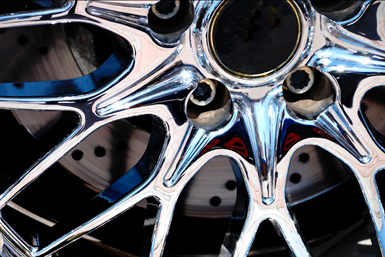How to Choose Between Sulfate and Chloride-Based Trivalent Chromium
There are several factors to consider when choosing between sulfate and chloride-based baths for trivalent chromium plating. Mark Schario of Columbia Chemical discusses the differences and what platers should keep in mind when evaluating options.

Q. We are a decorative plater in the automotive industry and have finally made the decision to switch over from hexavalent to trivalent chromium plating. I understand there are differences between sulfate- and chloride-based baths. Can you explain the differences between the two and what factors we may want to consider as we evaluate our options?
A. There are several factors, both operational and performance-wise, to consider when it comes to evaluating the difference between the two types of baths. From an operational standpoint, the first and most relevant factor to compare is the plating speed. When making the switch to decorative trivalent plating, many shops look at their existing line layout and timing and want to maintain as close to the same process and plating speed as they have with hexavalent plating to maintain their efficiency. Chloride-based systems usually plate at least twice as fast as sulfate systems, so this is an important factor to consider, especially if you have a return automatic plating line.
For example, if your current hexavalent plating time is two minutes, you can use the same plating time when using chloride-based trivalent to get an equivalent thickness and performance. From an operational standpoint, you only need to change the tank equipment and solution; you would not need to add stations to your return automatic line. With a sulfate-based system, you would likely need to add stations to accommodate the slower plating time.
The second operational factor to evaluate between the two systems is the difference in anodes. Chloride-based systems utilize a graphite anode that can last indefinitely under proper operating conditions. Sulfate-based systems utilize a more costly mixed-metal oxide (MMO) anode that requires recoating either after extended operation or if it gets scratched. Shops that use sulfate systems will often have two sets of anodes to ensure continuous operation as MMO anodes will generate hexavalent chromium if the coating is compromised, which completely contaminates the sulfate-based trivalent bath.
From a performance standpoint, the color, or brightness, of the trivalent chromium-plated deposit is one of the most common factors that drive the decision when switching from hexavalent to trivalent. Hexavalent plating set the color standard benchmark with an L value of 81-83. Initially, the first chloride-based systems averaged an L value of 74-75, while sulfate-based systems were averaging an L value of 75-77, resulting in an early preference due to a brighter finish. However, recent developments and newer technology in chloride-based trivalent plating systems provide a finish that is, in many instances, as white as or whiter than sulfate-based systems, with some L values ranging from 78-81. When working with a supplier to evaluate both types of systems, be sure to ask for samples and BYK-Gardner color/gloss test results to accurately assess the L value of each process.
Directly related to the color, and a key consideration for any plater doing decorative work for automotive OEMs right now, is the color stability of each type of trivalent system. In 2019, the United States Council for Automotive Research (USCAR) released the findings of its “Final Assessment of Decorative Trivalent Chromium Exposure in Winter Environments” which was a multi-year, comprehensive field study. As part of the original goal to identify whether chloride or sulfate-based trivalent chrome processes perform better in the areas of general and high-chloride corrosion and overall color stability, USCAR evaluated the L, a, b values of the chromium deposits before and after the field tests with appearance observations. Test results and conclusions through year three show chloride systems were color stable on L values, while sulfate systems degraded in L values over time. The group felt replacement parts may not match. (Learn more about the USCAR field test for trivalent chrome: short.pfonline.com/USCARfieldtest.)
Finally, another important component to consider is corrosion performance of the two systems. This factor was also examined in the USCAR study and its findings are worth referencing in your evaluation. As part of the three-year field study, chloride systems were tested against the sulfate systems and performed better in high-chloride corrosive environments than the sulfate systems. With respect to the specific performance in high-chloride regions, the study found high-chloride chromium corrosion (Russian mud) was more prevalent on sulfate-based chemistries than on chloride-based chemistries. The study revealed that 13 of 14 chemistries with significant chrome loss were sulfate systems. Again, these test results are specific to the USCAR field study released in 2019, but the information is worthy of reference and consideration for any decorative plater working with automotive OEMs.
When evaluating the differences between chloride- vs. sulfate-based trivalent plating baths, the operational components of plating speed and anode type and functionality, as well as the performance components of color, color stability and corrosion performance, are some of the key factors to consider to help you make the proper decision. With hexavalent plating subject to increasing and ever-tightening regulations and controls for both environmental and worker exposure, many global and domestic manufacturers have already specified or are in the process of specifying trivalent chromium in their plans to meet the new regulations, so your change-over to decorative trivalent plating is well timed.
About the Author

Mark Schario
Mark Schario serves as Chief Technology Officer for Columbia Chemical. For more info, visit columbiachemical.com.
Related Content
Possibilities From Electroplating 3D Printed Plastic Parts
Adding layers of nickel or copper to 3D printed polymer can impart desired properties such as electrical conductivity, EMI shielding, abrasion resistance and improved strength — approaching and even exceeding 3D printed metal, according to RePliForm.
Read MoreInnovation in Plating on Plastic
Plating on advanced plastics solution offers improved adhesion, temperature resistance and cost savings.
Read MoreHow to Maximize Nickel Plating Performance
The advantages of boric acid-free nickel plating include allowing manufacturers who utilize nickel plating to keep up the ever-changing regulatory policies and support sustainability efforts.
Read MoreA Chromium Plating Overview
An overview of decorative and hard chromium electroplating processes.
Read MoreRead Next
Columbia Chemical Granted General Motors Decorative Plating Color Style Approvals
Columbia Chemical has received color approvals from General Motors for its TriCOL Trivalent Chromium Plating Process.
Read MoreColumbia Chemical's TriCol Process Enhances Metal Distribution
TriCol Décor process for trivalent chromium plating is chloride based for faster plating, according to the company
Read MoreEducation Bringing Cleaning to Machining
Debuting new speakers and cleaning technology content during this half-day workshop co-located with IMTS 2024.
Read More





















